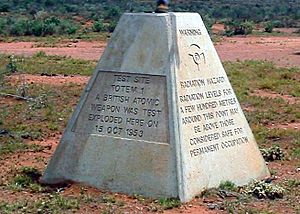Emu Field, South Australia facts for kids
Emu Field is a special place in South Australia. It is known as the site where the British government carried out two important nuclear tests in October 1953. These tests were part of something called Operation Totem. Sometimes, people also call this area Emu Junction or just Emu.
Preparing the Site
Before the tests could happen, a lot of work was done at Emu Field. In 1952, a surveyor named Len Beadell explored the area. Workers then built a small village and an airstrip. This was all to support the testing program. The site also received help from the nearby RAAF Woomera Range Complex.
The Nuclear Tests
Two nuclear weapon tests took place at Emu Field. These were:
- Totem I: This test happened on October 15, 1953. The device was placed on a tall tower. When it exploded, it had the power of 9 kilotons of TNT. (A kiloton is like 1,000 tons of TNT!)
- Totem II: This second test was on October 27, 1953. It was also on a tower. This explosion had the power of 7 kilotons.
Before these big nuclear tests, some smaller, regular explosions were also done. These were called the Kitten series of tests. They helped scientists check how certain parts of the nuclear devices would work.
After the Tests
After the first nuclear explosion, something unexpected happened. The invisible cloud of tiny radioactive particles did not spread out as planned. Instead, it moved north-east across Australia. This meant that areas far away could be affected by the invisible radiation.
Because of the invisible radiation, Emu Field became unsafe for more nuclear tests. Scientists had to find a new location. This search led them to Maralinga. A new series of atomic tests was carried out there in 1956.
Visiting Emu Field Today
Today, you can still visit Emu Field. Stone monuments mark the exact spots where the explosions happened. To visit, you need special written permission from the RAAF Woomera Test Range. This area is still very remote, meaning it's far from towns and cities.
Even now, you can see signs of the explosions on the ground. The sand at the center of the blasts melted and turned into a glassy material called Trinitite. You can also see circular patterns on the ground, like ripples, from the force of the explosions.



